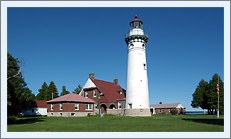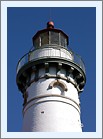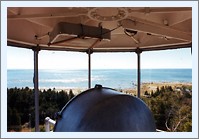|
Historical
Information

At the dawn of the
1880’s, the volume of maritime traffic passing between harbors on the
western shore of Lake Michigan and Green Bay and the Straits of Mackinac
exploded. While the St. Helena Island light station lighted the eastern
entry into the Straits, mariners were forced to navigate blind along 100
miles of unlighted upper peninsula coastline before the
Poverty Island
light came into view at the western end of the passage. With treacherous
storms frequent at both ends of the navigation season, mariners
frequently chose to ride out such storms in the lee of points protruding
into the lake along this 100-mile stretch of unlighted shoreline.
Seeking to both make identification of such a refuge easier, and to
mark the shore at an interim point between the two existing lights, the
Lighthouse Board recommended that establishment of a light station on
the end of Point Patterson, approximately midway between St. Helena
Island and Manistique. Unable to determine the need for such a light,
Congress referred the matter to the Commerce Committee for evaluation,
with the Committee returning a favorable report on February 15, 1882. A
bill appropriating $15,000 for the station’s construction passed through
the Senate on May 4, 1882, however the bill failed to pass on a vote in
the House, and the matter was dropped. In reconsideration its
recommendation, the Lighthouse Board determined that Seul Choix Pointe,
approximately 20 miles to the west of Point Patterson actually
represented a better location for the light, and submitted a request for
funding of a light in the revised location in its 1885 annual report.
Evidently this time Congress concurred with the need for the station, as
a $15,000 appropriation for establishing the new station passed both
houses on August 4, 1886.
A survey of Seul Choix Pointe was conducted late that year, and a
6.1-acre site at the southernmost end of the Point selected for the
station, and negotiations for its purchase undertaken with Archibald
Newton, the owner of the property. Newton and his two brothers had early
attained financial success as fishermen in northern Lake Michigan,
establishing a booming town around the natural bay on the eastern shore
of St. Helena Island. Archibald had attained local fame in 1856, when
under his leadership a fleet of vessels sailed from St. Helena to Beaver
Island to drive out the followers of renegade Mormon "King" James Jesse
Strang after his assassination by a couple of his disgruntled flock.
Over the ensuing years, the Newtons spread their fishing operations
westward along the north shore all the way to Seul Choix, and operated a
fleet of schooners out of St. Helena which trading goods for fish with
fishermen throughout the northern end of the lake. While Newton was
universally recognized as the landowner of virtually all of Seul Choix
Pointe, proving clear title to the surveyed property was less than a
simple task, with previous inconsistencies in title documents preventing
transfer of title to the Federal government until June 17, 1889.
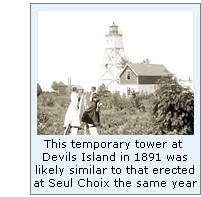 In the meantime, plans and specifications for construction of the
station buildings and mechanical systems had been completed and
approved, and with clear title in hand, bids for construction could be
advertised. However, with the closest bid coming in at more than $3,000
beyond the limits of the appropriation, a second round of bids were
sought in the hope that some contractor would be willing to do the work
for less. When this second group of bids came in similarly beyond the
appropriated amount, the Board had no alternative but to request an
additional $3,500 appropriation for the work in its 1890 annual report.
Realizing the important role this light would play to mariners, the
decision was also made to seek funding for the establishment of a
first-class fog signal at the station, and a request for a separate
appropriation of $5,500 for its construction asked in that same report. In the meantime, plans and specifications for construction of the
station buildings and mechanical systems had been completed and
approved, and with clear title in hand, bids for construction could be
advertised. However, with the closest bid coming in at more than $3,000
beyond the limits of the appropriation, a second round of bids were
sought in the hope that some contractor would be willing to do the work
for less. When this second group of bids came in similarly beyond the
appropriated amount, the Board had no alternative but to request an
additional $3,500 appropriation for the work in its 1890 annual report.
Realizing the important role this light would play to mariners, the
decision was also made to seek funding for the establishment of a
first-class fog signal at the station, and a request for a separate
appropriation of $5,500 for its construction asked in that same report.
On August 29, 1891, the lighthouse tender
WARRINGTON departed from
the Detroit Depot bound for Seul Choix Pointe loaded with building
materials and a construction crew under the direction of Ninth District
construction superintendent Todd. Expectations were high that the work
would be carried far enough by the end of the year that the light would
be exhibited at the opening of the 1892 navigation season. However, on
arrival at the site it quickly became evident that the plan to use
rubble stone from the area in building the dwelling cellar was
impossible, as the local stone was found to be altogether too soft and
flaky for the intended purpose. As a result, construction was virtually
halted while the crew waited for a shipment of cement and aggregate from
which to construct the cellar walls. To exacerbate the problem, the fall
of 1891 was particularly stormy, again bringing construction to a halt
on numerous occasions. With the dwelling barely complete, and the
masonry of the tower laid only to a height of 20 feet, it became clear
that there was no way the work would be brought anywhere close to
completion that year.
In order to ensure that a light would be exhibited on the opening of
the 1892 navigation season in accordance with the terms of the
appropriation, Ninth District Engineer Major William Ludlow authorized
the erection of a temporary beacon on the point at a cost of $850.
Consisting of an open frame timber structure with diagonal bracing, the
upper part was enclosed to create a service room, and a place to work on
the light during inclement weather. Within the cast iron lantern atop
the service room, a fixed white
Fourth Order Fresnel lens was installed
47 feet above the ground, and at a focal plane of 56 feet above lake
level, making the light visible for a distance of 15 miles in clear
weather. Work on the beacon was completed just in time as the onset of a
particularly bitter winter put an end to construction on the point on
November 16, and the work crew left for the season. Captain Joseph
Fountain, who was serving as keeper of the Beaver Island Harbor Light
was selected as the keeper of the new Seul Choix Pointe light on January
23, and he exhibited the light for the temporary tower on the opening of
the 1892 navigation season.
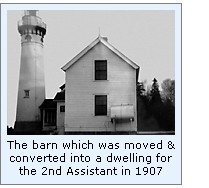 Colonel
Orlando M. Poe took over for Ludlow as Chief Engineer of the
Ninth Lighthouse District on June 22, 1892 to discover that he had
inherited a veritable rat’s nest at Seul Choix. A combination of poor
planning and shoddy accounting practices were pushing costs far beyond
the amount of the original appropriation. As if the additional costs of
purchasing and shipping concrete, erecting the temporary beacon, and
lost labor awaiting materials and sitting out bad weather weren’t
enough, it was discovered that a serious accounting error had been made.
The costs of the camp outfit, tools and other equipment used in
construction had been charged directly to the Seul Choix appropriation,
when they should have been charged to the general fund, as they would
remain usable in other projects after the construction at Seul Choix was
complete. As a result, Poe called a halt to construction, and
recommended an additional appropriation of $5,500 to cover the shortfall
in the Lighthouse Board’s 1892 annual report, along with a repeated
request for the $5,500 appropriation for establishing the fog signal at
the point. Colonel
Orlando M. Poe took over for Ludlow as Chief Engineer of the
Ninth Lighthouse District on June 22, 1892 to discover that he had
inherited a veritable rat’s nest at Seul Choix. A combination of poor
planning and shoddy accounting practices were pushing costs far beyond
the amount of the original appropriation. As if the additional costs of
purchasing and shipping concrete, erecting the temporary beacon, and
lost labor awaiting materials and sitting out bad weather weren’t
enough, it was discovered that a serious accounting error had been made.
The costs of the camp outfit, tools and other equipment used in
construction had been charged directly to the Seul Choix appropriation,
when they should have been charged to the general fund, as they would
remain usable in other projects after the construction at Seul Choix was
complete. As a result, Poe called a halt to construction, and
recommended an additional appropriation of $5,500 to cover the shortfall
in the Lighthouse Board’s 1892 annual report, along with a repeated
request for the $5,500 appropriation for establishing the fog signal at
the point.
With funding still unforthcoming in the summer of 1893, an inspection
of the construction site indicated that there had been significant
deterioration of the partially erected structures since construction was
halted the prior year. Much of work already done was significantly
damaged that it needed to be torn down and started over, significantly
adding to the costs Poe allowed for in his 1892 request for additional
funding. Moreover, the passage of the 8-hour labor law early in 1893
made it inevitable that labor costs would increase dramatically on the
resumption of construction, as lighthouse crews had historically toiled
from dawn to dusk, a practice which the act eliminated.
Unfortunately, Poe was faced with requesting more funds at the most
inopportune period in decades. Earlier that year, the Reading Railroad
went into receivership, with a number of other smaller railroads falling
in its wake. The situation was quickly exacerbated by the failures of
hundreds of banks and businesses that depended upon the railroads. The
stock market reacted with a dramatic plunge, European investors pulled
their funds out of US markets, and the US economy spiraled into a four
year Depression. With plummeting tax revenues, Congress was hard pressed
to make ends meet, and the problems associated with building a
lighthouse on an far off point in Lake Michigan with a French name that
nobody could pronounce was inevitably pushed to the bottom of the pile.
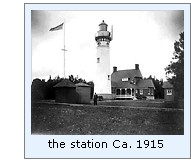 With funding thus unlikely, Poe conducted an analysis of all funded
projects in the district to identify if there were any unexpended
appropriations which could be reassigned to allow the completion of work
at Seul Choix Pointe, which had now been sitting in a decaying state for
two years. A likely candidate was identified in the St. Mary’s River,
where a $5,000 appropriation for relocating the Upper Range lights had
been made on August 5, 1892, but the work had yet to be started.
Determining the completion of the station at Seul Choix to be more
critical to maritime commerce relocating the range, Poe suggested to the
Board that permission be obtained to redirect the $5,000 appropriation
to Seul Choix, and concurring with the determination the Lighthouse
Board recommended that action to Congress in its annual report for 1894.
Since the solution required no additional funding, Congress approved the
funding reallocation in the Sundry Civil Appropriation Act of August 18,
1894, and also included an appropriation of $2,200 for beginning
construction of the fog signal building. With funding thus unlikely, Poe conducted an analysis of all funded
projects in the district to identify if there were any unexpended
appropriations which could be reassigned to allow the completion of work
at Seul Choix Pointe, which had now been sitting in a decaying state for
two years. A likely candidate was identified in the St. Mary’s River,
where a $5,000 appropriation for relocating the Upper Range lights had
been made on August 5, 1892, but the work had yet to be started.
Determining the completion of the station at Seul Choix to be more
critical to maritime commerce relocating the range, Poe suggested to the
Board that permission be obtained to redirect the $5,000 appropriation
to Seul Choix, and concurring with the determination the Lighthouse
Board recommended that action to Congress in its annual report for 1894.
Since the solution required no additional funding, Congress approved the
funding reallocation in the Sundry Civil Appropriation Act of August 18,
1894, and also included an appropriation of $2,200 for beginning
construction of the fog signal building.
 Revised estimates for completing the tower and dwelling were
formulated over the winter of 1894, and bids for the materials needed
for the completion of the work were advertised on March 9, 1895. The
materials and working party were loaded aboard the Lighthouse tender
AMARANTH, and delivered to Seul Choix on the opening of the 1895
navigation season. Work at the point was renewed at a feverish pace, and
by the end of June significant progress had been made. The dwelling had
been completely re-plastered, an oil house was completed, the tower had
been raised to a height of 56’ 4", construction of the boathouse was
nearly complete, masons were cutting limestone arches for the upper
tower windows, and the cast iron stairs had been installed in the tower
to the third platform level. Additionally, the brick fog signal building
had been completed, and the brick foundations for the duplicate steam
boilers completed and awaiting delivery of the boilers and associated
piping. With construction nearing completion at the end of July, the
magnificence of the station’s design was evident. Revised estimates for completing the tower and dwelling were
formulated over the winter of 1894, and bids for the materials needed
for the completion of the work were advertised on March 9, 1895. The
materials and working party were loaded aboard the Lighthouse tender
AMARANTH, and delivered to Seul Choix on the opening of the 1895
navigation season. Work at the point was renewed at a feverish pace, and
by the end of June significant progress had been made. The dwelling had
been completely re-plastered, an oil house was completed, the tower had
been raised to a height of 56’ 4", construction of the boathouse was
nearly complete, masons were cutting limestone arches for the upper
tower windows, and the cast iron stairs had been installed in the tower
to the third platform level. Additionally, the brick fog signal building
had been completed, and the brick foundations for the duplicate steam
boilers completed and awaiting delivery of the boilers and associated
piping. With construction nearing completion at the end of July, the
magnificence of the station’s design was evident.
The duplex dwelling consisted of a red brick structure on a stone
foundation with ashlar limestone above grade to reduce deterioration of
the brick. All trim work was painted in a buff color, and the roof
capped with red metal shingles. The interior of the building was laid
out with four rooms in each apartment, 5 closets a pantry, drawing room
and a vestibule at each entry.
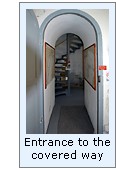 Attached to the dwelling by a covered way, the white painted brick
tower stood 18’ in diameter immediately above the foundation, and
gracefully tapered to a diameter of 12’ 4" in diameter beneath the
gallery. Of double-walled design, the outer wall stood 20"in thickness
at the base and tapered to 17" in thickness at the gallery. The 8’
diameter inner wall stood 9" in thickness, with the two walls separated
by an air space tapering from 29" at the base to 9" at the gallery, with
radial buttresses between the two walls to anchor them together. 86 cast
iron spiral stairs wound their way vertically within the inner cylinder,
passing through 2 landings and leading to a hinged scuttle in the iron
watch room floor. Four arched windows with carved limestone lintels were
located on the compass points in the watch room, and provided an
excellent view of the lake. Attached to the dwelling by a covered way, the white painted brick
tower stood 18’ in diameter immediately above the foundation, and
gracefully tapered to a diameter of 12’ 4" in diameter beneath the
gallery. Of double-walled design, the outer wall stood 20"in thickness
at the base and tapered to 17" in thickness at the gallery. The 8’
diameter inner wall stood 9" in thickness, with the two walls separated
by an air space tapering from 29" at the base to 9" at the gallery, with
radial buttresses between the two walls to anchor them together. 86 cast
iron spiral stairs wound their way vertically within the inner cylinder,
passing through 2 landings and leading to a hinged scuttle in the iron
watch room floor. Four arched windows with carved limestone lintels were
located on the compass points in the watch room, and provided an
excellent view of the lake.
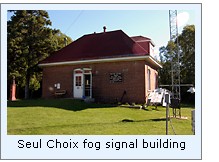 Above the watch room, the gallery was supported by sixteen carved
limestone corbels, and surrounded by a delicate but sturdy iron railing.
Atop the service room, the decagonal third order lantern stood 8 feet in
diameter, and featured nine ¼" thick glass plates, each 31 ¼" wide by 69
¾" in height, and was surmounted by a copper roof with a zinc inner
lining. The fixed white
Third Order Fresnel lens was installed atop a
sturdy cast iron pedestal, which rose from the floor of the service room
into the lantern, placing the lens at a focal plane of 79 feet above
mean lake level. Manufactured by Henry-Lepaute of Paris, the lens
incorporated a lower catadioptric belt of 4 prisms, a dioptric center
drum of 13 elements, and an upper catadioptric belt of 11 prisms.
Illuminated with a state of the art kerosene fueled 3-wick Funck Heap
lamp with lamp plunger and float chamber, the lens was designed to be
visible from a distance of seventeen miles at sea in clear weather
conditions. Above the watch room, the gallery was supported by sixteen carved
limestone corbels, and surrounded by a delicate but sturdy iron railing.
Atop the service room, the decagonal third order lantern stood 8 feet in
diameter, and featured nine ¼" thick glass plates, each 31 ¼" wide by 69
¾" in height, and was surmounted by a copper roof with a zinc inner
lining. The fixed white
Third Order Fresnel lens was installed atop a
sturdy cast iron pedestal, which rose from the floor of the service room
into the lantern, placing the lens at a focal plane of 79 feet above
mean lake level. Manufactured by Henry-Lepaute of Paris, the lens
incorporated a lower catadioptric belt of 4 prisms, a dioptric center
drum of 13 elements, and an upper catadioptric belt of 11 prisms.
Illuminated with a state of the art kerosene fueled 3-wick Funck Heap
lamp with lamp plunger and float chamber, the lens was designed to be
visible from a distance of seventeen miles at sea in clear weather
conditions.
A series of plank walkways connected the dwelling to a brick oil
house, a brick privy, a wood frame boathouse and the 34’ by 20’ brick
fog signal building standing 108 feet southeast of the tower. To provide
steam for the single tone 10" steam whistle mounted above the roof, a
pair of locomotive-style boilers manufactured by the Miami Valley Boiler
Company of Dayton, Ohio sat on brick foundations within the building.
Operating at a pressure of 80 pounds per square inch, the whistles were
sequenced to emit the station characteristic single blast of four second
followed by 26 seconds of silence by a Crosby automatic timing device,
tripped by 3 cams on each cylinder.
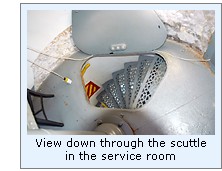 Work on the station was complete in August, and the fog signal placed
into operation on September 10, 1895. With the exhibition of the Third
Order lens for the first time on the night of August 15, the temporary
timber skeleton tower was disassembled and the components shipped to the
depot for storage. The fog signal was evidently a useful addition to
navigation as keeper Fountain and Assistant Patrick McCauley fed 51 tons
of coal and 3 cords of wood into the hungry boilers in order to keep the
whistle screaming a station high 573 hours during the 1896 navigation
season. Realizing that managing a first-class light station and such a
busy fog signal was more than a two-man crew could handle efficiently,
the decision was made to add a Second Assistant to the station’s roster.
Without quarters for the additional keeper, the Second Assistant likely
moved in with the First Assistant, which likely made for less than
desirable living conditions for both. Work on the station was complete in August, and the fog signal placed
into operation on September 10, 1895. With the exhibition of the Third
Order lens for the first time on the night of August 15, the temporary
timber skeleton tower was disassembled and the components shipped to the
depot for storage. The fog signal was evidently a useful addition to
navigation as keeper Fountain and Assistant Patrick McCauley fed 51 tons
of coal and 3 cords of wood into the hungry boilers in order to keep the
whistle screaming a station high 573 hours during the 1896 navigation
season. Realizing that managing a first-class light station and such a
busy fog signal was more than a two-man crew could handle efficiently,
the decision was made to add a Second Assistant to the station’s roster.
Without quarters for the additional keeper, the Second Assistant likely
moved in with the First Assistant, which likely made for less than
desirable living conditions for both.
Life at Seul Choix settled into a basic routine until 1901, when a
work crew arrived at the station to install a second iron floor in the
upper portion of the tower to form a watch room and a second oil storage
building was erected. The following year, the twin iron chimneys on the
fog signal building were demolished and replaced by a single brick
chimney into which both boilers were plumbed. Responding to the cramped
living conditions for the assistants, the station barn was relocated
next to the main dwelling and converted into a dwelling for the 2nd
Assistant in 1907.
With the arrival of electricity at the station in1925, the dwelling,
outbuildings and the light itself were electrified and the steam boilers
and whistles removed from the fog signal building and replaced by a
two-tone diaphone. Also this year, the dwelling was modified through the
addition of a wing which provided more suitable accommodations for the
Second Assistant. No longer serving any purpose as a dwelling, the old
converted barn was sold into private ownership, and its new owners moved
it to the shore of one of the nearby lakes where it served as a summer
cottage.
With the assumption of responsibility for the aids of navigation
transferred to the Coast Guard in 1939, three-man crews of seamen began
tending the station. In 1972, the station was finally automated through
the installation of a single
DCB-224 aero beacon with a characteristic
white flash every six seconds, which like the fixed Third Order lens it
replaced, was visible for a distance of 17 miles in clear weather
conditions. The following year, the Coast Guard closed up the station,
leaving the light to operate on an unmanned basis.
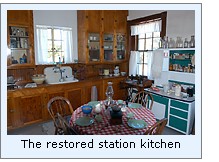 No longer serving any government purpose, the station buildings were
sold to the Michigan Department of Natural Resources to serve as a park
on June 20, 1977. After sitting untended for ten years, with the
exception of infrequent visits by Coast Guard AtoN crews to undertake
scheduled maintenance on the aero beacon, the buildings started to
deteriorate rapidly. Realizing the historical significance the station
represented, a group of concerned local citizens banded together to form
the Gulliver Historical Society on October 8, 1987, with their primary
charter being the restoration and preservation of the station and its
history. As part of this process, the Historical Society was successful
in having the station listed on the National Historic Register on August
8. 1988. After obtaining a Michigan Equity Grant the following year, the
Historical Society proudly opened the station to the public at a grand
opening celebration on August 6, 1989. No longer serving any government purpose, the station buildings were
sold to the Michigan Department of Natural Resources to serve as a park
on June 20, 1977. After sitting untended for ten years, with the
exception of infrequent visits by Coast Guard AtoN crews to undertake
scheduled maintenance on the aero beacon, the buildings started to
deteriorate rapidly. Realizing the historical significance the station
represented, a group of concerned local citizens banded together to form
the Gulliver Historical Society on October 8, 1987, with their primary
charter being the restoration and preservation of the station and its
history. As part of this process, the Historical Society was successful
in having the station listed on the National Historic Register on August
8. 1988. After obtaining a Michigan Equity Grant the following year, the
Historical Society proudly opened the station to the public at a grand
opening celebration on August 6, 1989.
Over the ensuing years, as a result of numerous private donations and
successful grant writing campaigns, the dwelling was restored and
re-furnished in time for the station’s centennial in 1995.

Keepers of
this Light

Click here
to see a complete listing of all Seul Choix
Pointe keepers compiled by Phyllis L. Tag of Great Lakes Lighthouse Research.

Seeing this Light

From the junction of US-2 and County Rd. 432 in Gulliver,
about 11 miles east of Manistique, go south on CR-432 (Port Inland Rd )
about 4 miles to County Rd. 431. Turn West onto CR-431, a gravel road
which will take you the four miles to the lighthouse. The museum opens
from 10am to 6pm daily from Memorial Day through mid September.

Contact information

For more information on visiting this
Light Station, call: 906-283-3183

Reference Sources

Annual reports of the Lighthouse Board,
various, 1885 – 1909
Annual reports of the Lighthouse Service, various, 1910 – 1929
Form 40 survey of the station, Francis Otter, District Draftsman,
1909
Notice to Mariners, August 8, 1895
Great Lakes Light Lists, various, 1892 – 1995
Detroit Free Press, May 13 & August 29, 1891
Lake Carriers Association annual reports, 1915 & 1925
Keeper listings for this light appear courtesy of Great Lakes Lighthouse
Research |
